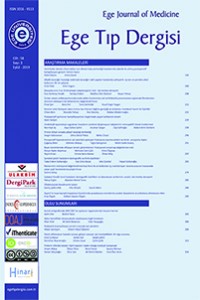Abstract
Akkiz hemofili, faktör 8’e karşı otoantikor
gelişmesi sonucu oluşan oldukça nadir görülen bir koagulasyon bozukluğudur.
Toplumda görülme sıklığı 1-4/1.000.000 olup sıklıkla ileri yaşlarda ortaya çıkmaktadır.
Hastalık 16 yaş altındaki çocuklarda 0.0045/milyon; 85 yaş üzerinde
14.7/milyon/yıl sıklığında görülür. Genellikle otoimmun, romatizmal veya malign
hastalıklar, gebelik ve ilaçlar ile ilişkili oluşur. Hastaların yaklaşık yarısında
etiyolojik faktör tespit edilemez. Başlıca belirtisi kas içine oluşan spontan kanamaların
varlığıdır. Burada akkiz hemofili hastasında gelişen bir hematom olgusu sunulmaktadır.
References
- Collins PW. Therapeutic challenges in acquired factor VIII deficiency. ASH Education Book 2012; 1: 369-74.
- Franchini M, Manucci PM. Acquired haemophilia: A 2013 update. Thromb Haemost 2013; 110 (6): 1114-20.
- Kessler1 CM, Knobl P. Acquired haemophilia: an overview for clinical practice. Eur J Haematol 2015; 95 (Suppl 81): 36-44.
- Huang YW, Saidi P, Philipp C. Acquired factor VIII inhibitors in non-haemophilic patients: clinical experience of 15 cases. Haemophilia 2004; 10 (6): 713-21.
- Huth-Kühne A, Baudo F, Collins P, et al. International recommendations on the diagnosis and treatment of patients with acquired hemophilia A. Haematologica 2009; 94 (4): 566-75.
- Ma AL and Carrizosa D. Acquired Factor VIII Inhibitors: Pathophysiology and Treatment. Hematology Am Soc Hematol Educ Program 2006; 431-7.
- Cohen AJ, Kessler CM. Acquired inhibitors. Baillieres Clin Haematol 1996; 9 (2): 331-54.
Abstract
Acquired hemophilia is a rare coagulopathy that results in
autoantibody development against factor 8. The incidence in the society is 1-4
/ 1.000.000 and it frequently occurs at older ages. The disease occurs in children
under 16 years of age with a frequency of 0.0045 / million, and a frequency of 14.7/million/year
over 85 years. It is usually associated with autoimmune, rheumatic or malign diseases,
pregnancy and medications. Approximately half of the patients cannot be identified
with the etiologic factor. The main symptom is the presence of spontaneous hemorrhages
in the muscle. Here we present a hematoma in a patient with acquired hemophilia.
References
- Collins PW. Therapeutic challenges in acquired factor VIII deficiency. ASH Education Book 2012; 1: 369-74.
- Franchini M, Manucci PM. Acquired haemophilia: A 2013 update. Thromb Haemost 2013; 110 (6): 1114-20.
- Kessler1 CM, Knobl P. Acquired haemophilia: an overview for clinical practice. Eur J Haematol 2015; 95 (Suppl 81): 36-44.
- Huang YW, Saidi P, Philipp C. Acquired factor VIII inhibitors in non-haemophilic patients: clinical experience of 15 cases. Haemophilia 2004; 10 (6): 713-21.
- Huth-Kühne A, Baudo F, Collins P, et al. International recommendations on the diagnosis and treatment of patients with acquired hemophilia A. Haematologica 2009; 94 (4): 566-75.
- Ma AL and Carrizosa D. Acquired Factor VIII Inhibitors: Pathophysiology and Treatment. Hematology Am Soc Hematol Educ Program 2006; 431-7.
- Cohen AJ, Kessler CM. Acquired inhibitors. Baillieres Clin Haematol 1996; 9 (2): 331-54.
Details
| Primary Language | Turkish |
|---|---|
| Subjects | Health Care Administration |
| Journal Section | Case Reports |
| Authors | |
| Publication Date | September 20, 2019 |
| Submission Date | June 11, 2018 |
| Published in Issue | Year 2019Volume: 58 Issue: 3 |


